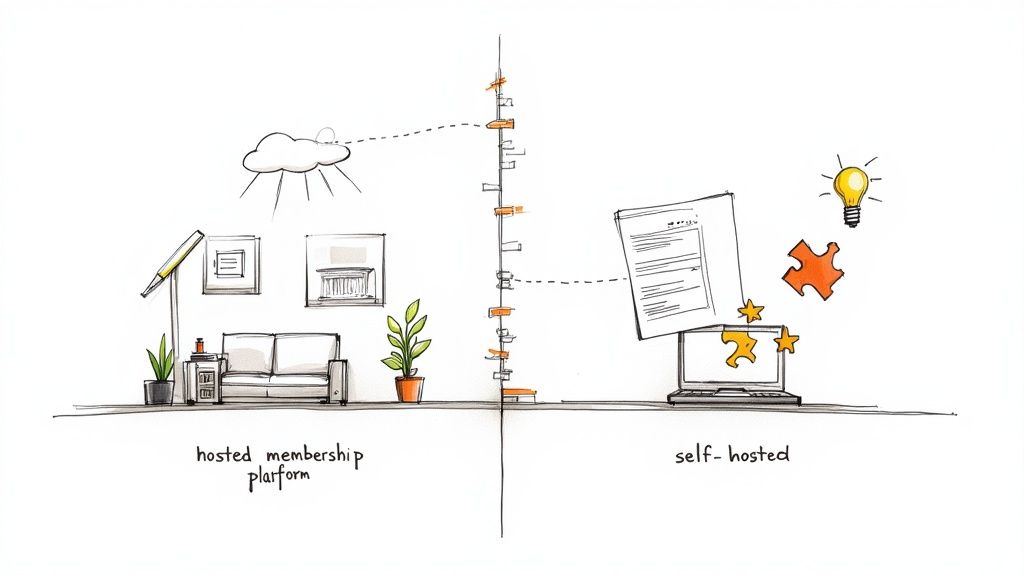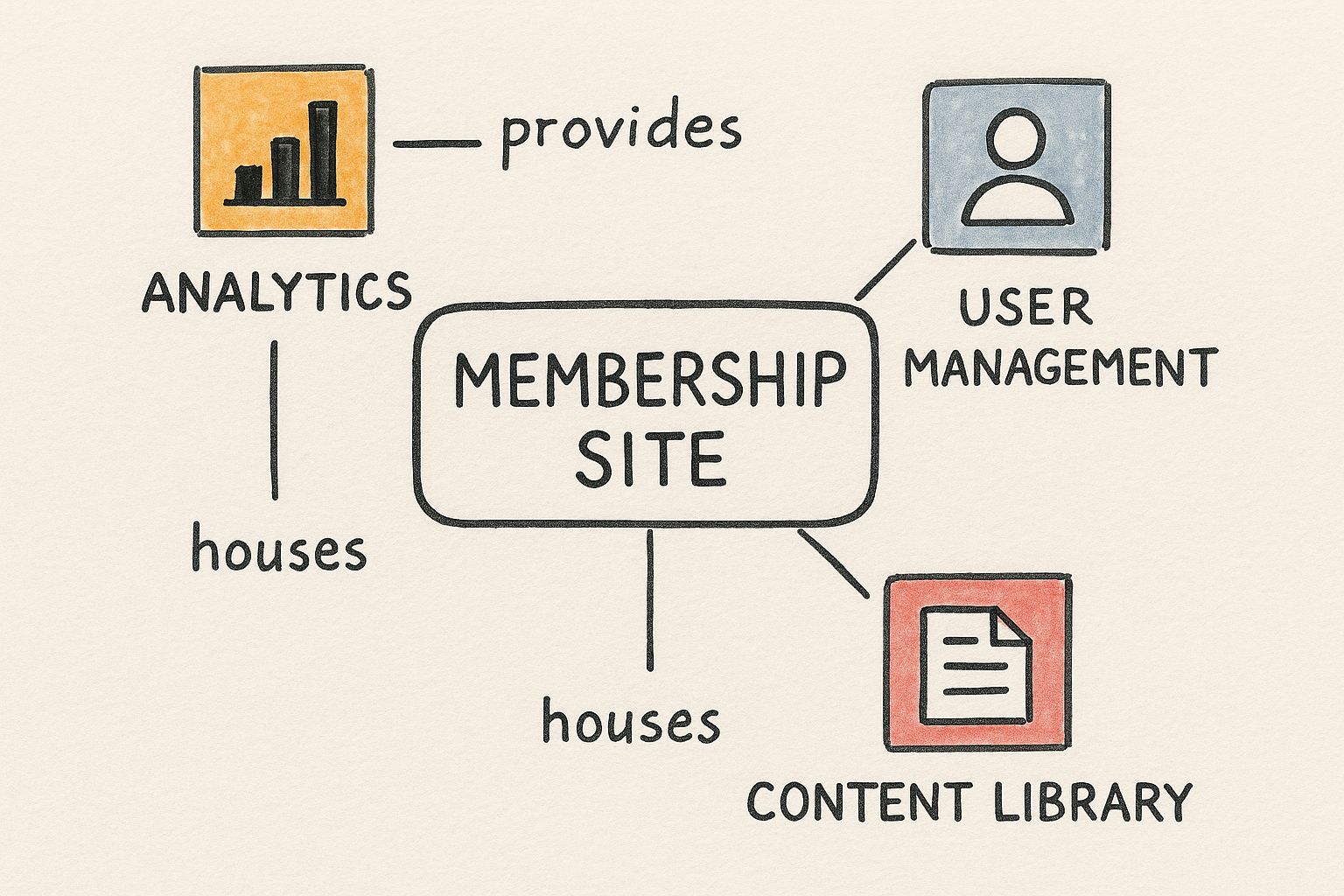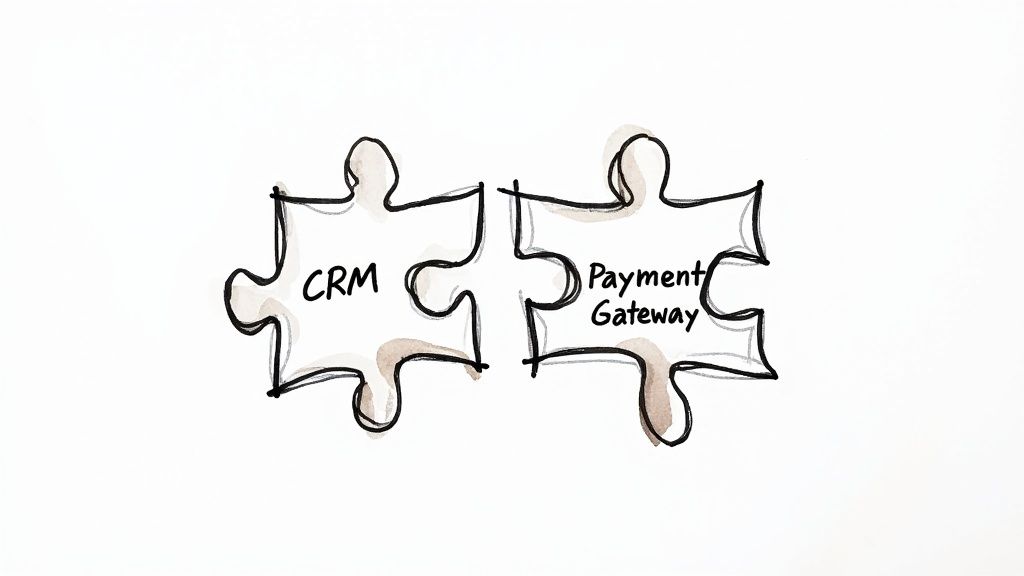July 22, 2025

Think of a membership site platform as the complete toolkit for building and running your very own online club. It’s the software that handles all the technical heavy lifting—from protecting your exclusive content to processing payments—so you can focus on what you do best: serving your community.
So, you have an idea, an expertise, or a thriving audience you want to bring together. The dream is to create a sustainable business around it, one that generates predictable, recurring income. But how do you actually build that secure, members-only space where all the magic happens?
This is precisely where a dedicated membership site platform comes in. It’s much more than a simple website builder; it's the specialized operating system designed specifically for a subscription-based business. It takes care of all the crucial, behind-the-scenes tasks that would otherwise be a massive headache.
Imagine trying to build this from scratch. You'd be stuck duct-taping different tools together: one for payments, another to lock down your premium content, a third for managing who has access, and maybe even a fourth for community chats. The result? A clunky, disjointed mess for both you and your members.
A proper membership platform rolls all of those jobs into a single, elegant system.
The need for these integrated solutions is exploding. The global market for membership management software is expected to jump from $7.63 billion in 2024 to $8.57 billion in 2025. That’s a huge leap, and it’s all driven by creators and businesses looking for smarter ways to operate online.
There’s a well-known saying in the creator world: "People join for the content, but they stay for the community." A great platform gives you the power to deliver both, creating a 'sticky' experience that keeps members coming back.
This is why picking the right foundation is so important. Your choice of platform directly shapes your ability to:
To make this crystal clear, let's break down the essential jobs a platform does for you.
This table translates the technical features into the practical benefits you'll actually experience as a creator.
Ultimately, a membership site platform isn't just a piece of tech. It’s the strategic partner that empowers you to build a profitable and genuinely connected online community. If you're ready to explore your options, our complete guide to choosing a membership platform is the perfect next step.
When you're ready to build your membership site, one of the first big decisions you'll make is about the foundation itself. It really boils down to two main paths: using a hosted, all-in-one platform or building on WordPress with a dedicated plugin.
Think of it like this: are you renting a fully-furnished apartment or are you building a custom home from the ground up?
A hosted platform is your furnished apartment. You sign up, get the keys, and everything is already there—the furniture, the utilities, the security system. The platform provider handles all the technical headaches like maintenance and updates, so you can move right in and focus on what matters: creating great content and engaging with your members. It's designed for simplicity and getting you up and running fast.
On the other hand, a WordPress plugin is the custom home approach. You own the land (your web hosting), and you have total freedom to design every single detail. You pick the architectural style (your theme), the appliances (other plugins), and how every room is laid out. This gives you incredible control and flexibility, but it also means you’re the general contractor. You're responsible for maintenance, security, and making sure everything works together.
Hosted platforms are exactly what they sound like: a single solution that bundles everything you need under one roof. For a monthly or annual fee, you get the software, web hosting, security, and customer support all rolled into one package.
The biggest draws here are:
Of course, that convenience comes with a few trade-offs. You give up a degree of control over deep customization, and your business is built on someone else's platform. If you ever want to leave, moving all your content and members can be a major project.
The WordPress route is all about freedom and ownership. The numbers show just how popular this approach is for creators who want that control.
A recent study found that a staggering 65.52% of membership sites run on a WordPress plugin. This massive market share shows that for many, the limitless potential of the WordPress ecosystem outweighs the simplicity of a hosted service. You can dig into the numbers in the full membership site study.
No matter which path you choose, you'll be managing the same core components—content, users, payments, and analytics. The main difference is how you manage them.

This map just gives you a sense of how all the pieces, from your content library to your member database, fit together inside your platform's dashboard.
The biggest advantages of building with a WordPress plugin include:
The main downside is the responsibility that comes with it. You’re the one in charge of hosting, security updates, backups, and fixing things when plugins don't play nicely together. This path is perfect for those who are tech-savvy or have the budget to hire a developer.
Ultimately, there's no "better" choice—only the right fit for your skills, your budget, and your vision for the future.
Deciding between a hosted service and a WordPress plugin is your first big choice, but the features are what will make or break your business day-to-day. These are the tools that do the heavy lifting: managing your members, keeping your content secure, and most importantly, making sure you get paid. Without the right toolkit, even the most amazing content won't translate into a sustainable business.
Think of it like building a workshop. You can have the best raw materials in the world, but without a solid workbench, sharp tools, and a reliable power source, you're not going to build much. The same goes for your membership site; some features are simply non-negotiable.
Let's look at the absolute must-haves.
At its heart, a membership site exists to protect your valuable content. This is often called content gating, and it's what puts up a paywall, restricting access to your pages, courses, videos, or downloads so only paying members can get in. It’s the digital version of a "members-only" sign on a clubhouse door.
But it’s not just an on/off switch. A truly capable platform lets you create tiered membership levels. This is where you can offer different packages at different prices—think Bronze, Silver, and Gold. For instance, a Bronze member might get your weekly newsletter, while a Gold member gets the newsletter, a monthly masterclass, and access to a private community.
This kind of flexibility is a powerful way to grow your revenue. It lets you meet people where they are, both in terms of their needs and their budget, while giving them a clear path to upgrade as they get more value from your work.
A well-designed tier structure does more than just make you money—it makes your offer crystal clear. When potential customers can easily see the benefits of each level, it makes their decision to join (and eventually upgrade) a whole lot easier.
The engine behind all this is a simple but powerful rules system. The best platforms let you set up "if-then" conditions to control who sees what.
This screenshot from MemberPress shows a perfect example. You can set a rule to protect every post in a certain category and then grant access only to members on the "Silver Membership" plan. With controls like this, you can build out a complex and valuable content library without any coding or headaches.
Let's be honest: nobody wants to spend their time chasing down payments. Your platform absolutely must have automated payment processing. It should connect seamlessly with trusted payment gateways like Stripe or PayPal to handle recurring subscriptions, deal with failed payments, and give your members a secure and easy checkout process.
Another feature that’s critical for keeping members around is drip content. Instead of dumping your entire library on a new member all at once (which can be incredibly overwhelming), a drip feature releases content over time. For example, a new subscriber might get Module 1 on day one, unlock Module 2 a week later, and so on.
This strategy is brilliant for a couple of reasons:
It’s one thing to talk about "gated content" and "recurring revenue" in theory. It’s another to see it in action. The real power of a membership platform becomes clear when you look at how actual creators and entrepreneurs are using them to build thriving businesses.

This business model isn't just a trend; it's a significant shift. A staggering 66.8% of membership sites were launched within the last three years alone, as more people chase the stability of predictable income. The most successful niches? Business and education, which each capture over 22% of the market. You can dive deeper into these numbers in this detailed membership statistics report from uscreen.tv.
Let's break down a few popular ways people are putting these platforms to work.
Picture a financial expert who teaches people about personal budgeting and investing. Instead of selling one-off courses, they use a membership site to house their entire educational world.
For a small monthly fee, a basic member might get access to a foundational budgeting course. For a higher price, a premium member could unlock advanced investing workshops, downloadable spreadsheets, and even get face-time in a live monthly Q&A session.
For this to work, the platform absolutely needs:
Now, think about a business coach who leads a high-end mastermind for seasoned entrepreneurs. Here, the value isn't just the coach's content—it's the power of the group itself. The membership site platform becomes the private, central hub for this exclusive community.
They join for the content, but they stay for the community. This old saying is the entire foundation of a great mastermind. Your platform has to nail the community aspect.
The coach might host weekly group calls, moderate discussions in a private forum, and share a library of proven templates and business frameworks. But the real magic happens when members start connecting with each other, collaborating on projects, and holding one another accountable. All of this is facilitated within the secure walls of the platform. For this model, features like forums, detailed member profiles, and event calendars are essential.
Finally, let’s look at a creator with a passionate following around a specific hobby, like sustainable gardening. They've built an audience on YouTube and a blog, but they use a membership to offer something more.
For a few dollars a month, members get exclusive content they can't find anywhere else: in-depth planting guides, a community seed-swapping directory, and a forum to share their gardening wins (and woes!).
This creator uses their platform to build a tight-knit community of fellow enthusiasts who are more than happy to pay for specialized knowledge and a direct connection to like-minded people. Success here rides on having great community features and a simple way to upload and organize content.
Picking a membership site platform can feel overwhelming. With so many choices out there, all promising to make your life easier and your business bigger, how do you find the one that actually fits? The secret is to think beyond the marketing hype and look at your business not just as it is now, but where you see it in the next three years.
Choosing a platform is a serious commitment. Trust me, moving all your members, content, and payment setups down the line is a massive headache you want to avoid. It’s complicated, expensive, and disruptive. So, let's get it right the first time by asking some key questions.

This pricing table from Kajabi is a perfect example of what to look for. Notice how they bundle features and place limits on things like the number of products or active members you can have. Digging into these details is vital for figuring out what the platform will really cost you as you grow.
Before you start signing up for free trials and getting distracted by shiny new features, take a step back and create a checklist. This simple exercise forces you to compare platforms based on what your business actually needs, not just what a sales page tells you is important. The goal here is to find a solution you can grow into, not one you'll outgrow in six months.
The best place to start is with an honest look at your own situation. Here are the questions I always tell people to ask themselves:
A common mistake is choosing a platform based solely on its price today. The right platform is an investment. Prioritizing scalability and the right features from the start will save you immense headaches and lost revenue down the road.
Answering these questions gives you a personal scorecard for judging every membership site platform you look at. It turns a confusing decision into a much more logical, step-by-step process.
To help you even more, detailed comparisons can be a lifesaver. For a closer look at the leading contenders, check out our analysis of the best membership platform options available right now. It’ll give you some great context and show you how different tools measure up.
Even with a solid strategy in hand, a few practical questions always pop up when it's time to actually pick a membership site platform. That’s completely normal. This is a big decision that will shape your business for years to come, so let's tackle the most common concerns.
Getting clear on these points now will help you move forward with confidence and save you from some major headaches down the road.
The truth is, the startup cost for a membership site can vary quite a bit. The biggest fork in the road is deciding between a self-hosted WordPress plugin and an all-in-one platform, as this choice really sets the stage for your budget.
No matter which path you take, don't forget to account for payment gateway fees. Services like Stripe and PayPal typically take around 2.9% + $0.30 from every transaction. This is a universal cost of doing business online, so make sure to factor it into your pricing model.
Technically, yes, you can switch platforms. But I'll be honest—it’s rarely a walk in the park. Migrating a membership site means exporting all of your member data, your content, and crucial payment information, then importing it all perfectly into a new system. It's a complex puzzle that carries a real risk of data loss or, even worse, messing up your members' recurring payments.
Because of how disruptive a move can be, it's so much better to choose a platform that can grow with you from the very beginning. Thinking about your future needs now helps you avoid the massive technical and financial headache of a migration later on.
Many creators who find themselves in this situation end up hiring a developer or paying for a special migration service just to make sure it's done right, which only adds to the cost.
Absolutely not. While having a big email list is certainly a plus, a small but deeply engaged audience can be far more powerful, especially when you're just starting out. The real key isn't the number of followers you have, but the strength of the relationship you've built with them.
In fact, many of the most successful memberships I've seen were launched with a small, dedicated group of just 50-100 founding members. This initial group is pure gold. They give you priceless feedback, help you polish your offerings, and provide the authentic testimonials you'll need to attract the next wave of members. Focus on delivering incredible value to this core group, and you'll build a rock-solid foundation for growth.
This is a big one. While your amazing content is what gets people to sign up in the first place, community is what makes them stay. People might join for a course or a downloadable guide, but they remain paying members for the connections they forge with you and with each other. It’s the glue that holds everything together.
A platform that actively encourages member-to-member interaction with features like forums, direct messaging, or live group events is absolutely essential. Consistently showing up for your community and making them feel like a valued part of something special will do more to keep them around than anything else. Investing time in proven membership retention strategies is one of the smartest things you can do for the long-term health of your business.
Ready to build a thriving, engaged community without the technical headaches? GroupOS provides an all-in-one platform to manage your members, deliver content, and foster connections seamlessly. Start your free trial today and see how easy it is to launch and grow your membership business.


